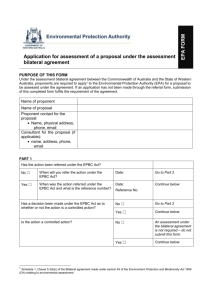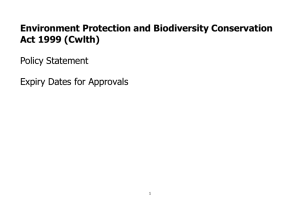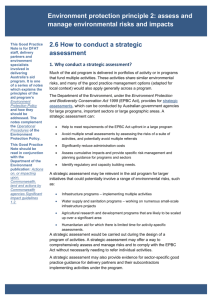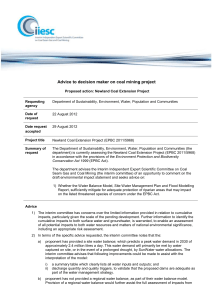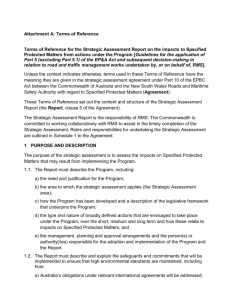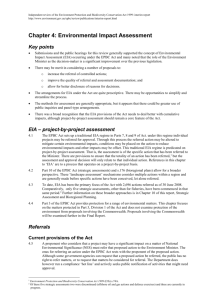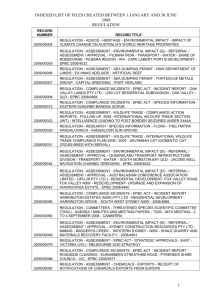Definition of *action - Department of the Environment
advertisement
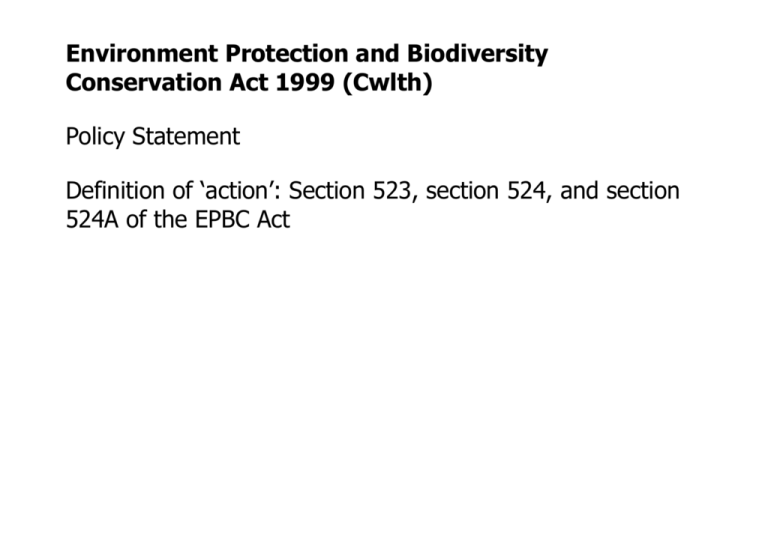
Environment Protection and Biodiversity Conservation Act 1999 (Cwlth) Policy Statement Definition of ‘action’: Section 523, section 524, and section 524A of the EPBC Act Contents Table of Contents Overview ..................................................... 2 Determining whether a proposal constitutes an action ………………………………………………………2 Step 1: Does the referral include an ‘action’, as defined by the EPBC Act? .............................. 2 Related activities .................................... 2 Non-physical actions .............................. 3 Step 2: Things that are not actions - is the activity a governmental authorisation or provision of grant funding? ………………………..3 Grant Funding ....................................... 3 Is failure to act an ‘action’? ..................... 4 Examples ..................................................... 4 Example 1 – Residential subdivision ........... 4 Example 2 – Failure to act ......................... 4 OVERVIEW This Policy Statement outlines the meaning of the term ‘action’ under the EPBC Act. The EPBC Act prohibits taking an ‘action’ that has, will have, or is likely to have a significant impact on the matters protected under Part 3 of the EPBC Act, without approval. Understanding the definition of an ‘action’ is therefore crucial to understanding whether the EPBC Act applies. DETERMINING WHETHER A PROPOSAL CONSTITUTES AN ACTION The following steps outline how to determine whether a proposal involves an ‘action’ and whether a relevant exception applies. Step 1: Does the referral include an ‘action’, as defined by the EPBC Act? A proposal must be an ‘action’ to be validly referred under the EPBC Act. Section 523 of the EPBC Act defines an action as including a project, development, undertaking, activity, or series of activities, or an alteration to any of those things. (The terms ‘project’, ‘development’, ‘undertaking’ and ‘activity’ have their ordinary dictionary meaning under this section.) Almost all proposals which will have a direct or indirect physical impact are likely to fall within the definition of an action under section 523. Section 523 of the EPBC Act includes (nonphysical) undertakings to do something within the definition of an ‘action’, if these non-physical acts 2 have a direct or indirect impact on a matter of national environmental significance (MNES) protected under Part 3. For example, the sale, lease or disposal of land (whether Commonwealth or other land) may be an action. While these activities may not have any direct impacts on any MNES in themselves, they may have indirect impacts, including those resulting from third party activities, which could result in significant impacts on matters protected under Part 3. The definition of an action under section 523 is inclusive, not exclusive, which means that other things not listed in this definition may also be determined to be an action, although most matters referred under the EPBC Act are covered by this definition. Related activities The use of terms such as ‘project’, ‘development’ and ‘series of activities’ within a referral indicates that a group of related activities could be treated as a single action. There is often a point at which each activity, whilst itself falling within the definition of an ‘action’, cannot be considered in isolation from the other activities it relates to. This may involve a determination of whether a referred action is a ‘split referral’ and, if so, whether the minister or delegate may, under section 74A of the EPBC Act, refuse to accept the referral on the basis that it is a component of a larger action the person proposes to take. Step 2: Things that are not actions - is the activity a governmental authorisation or provision of grant funding? Section 524 of the EPBC Act defines things that are not actions in relation to government bodies. Section 524 (1) applies to decisions by each of the following government bodies: (a) (b) the Commonwealth; a Commonwealth agency; (c) a State; (d) a self-governing Territory; (e) an agency of a State or self-governing Territory; or (f) an authority established by a law applying in a Territory that is not a self-governing Territory. Subsection 524(2) provides that a decision by any of these bodies to grant a governmental authorisation (however described) for another person to take an action is not an ‘action’ as defined by the EPBC Act. Subsection 524(3) further states that, to avoid doubt, a decision by the Commonwealth or a Commonwealth agency to grant a governmental authorisation under one of the following acts is not an action: Customs Act 1901; Export Control Act 1982: Export Finance and Insurance Corporation Act 1991; Fisheries Management Act 1991; Foreign Acquisitions and Takeovers Act 1975; Offshore Petroleum and Greenhouse Gas Storage Act 2006; Quarantine Act 1908; and Competition and Consumer Act 2010. Examples of governmental authorisations include work approvals granted by a government body for highway constructions, issuing of permits, and granting of licences. The majority of the Full Federal Court in Save the Ridge Inc v Commonwealth [2005] FCAFC 203 (the Gungahlin Drive Extension Case) held that the concept of a ‘governmental authorisation’ should be interpreted broadly. In that case, the Court determined that amendments to the National Capital Plan were ‘governmental authorisations’, because they removed a legislative constraint on the construction of the Gungahlin Drive Extension (the Gungahlin Drive Extension Case). It did not matter that the government authorisations did not take the form of a permit or licence granted to the relevant ACT authority that was proposing to undertake the projects. Section 524 of the EPBC Act is not intended to exclude only the final or operative decision. It also excludes earlier decisions which are directly 3 connected to the making of the final decision. As such, in the Gungahlin Drive Extension Case the decisions and related steps taken in formulating and proposing the amendments to the National Capital Plan and the Minister’s decision to formally approve the amendments, constituted a governmental authorisation. In the Gungahlin Drive Extension Case, the Federal Court stated that it cannot be assumed that the actions of a planning authority could never be an ‘action’ under the EPBC Act. This will depend on what the authority did and the direct and indirect consequences of these actions. When considering whether the steps taken by a government authority are ‘governmental authorisations’, consideration must be given to the context in which those steps are taken. Grant Funding Under section 524A of the EPBC Act the provision of grant funding from a government body, as defined in paragraphs 524(1)(a) to (f), is not an ‘action’ for the purposes of the EPBC Act. A referral must be an ‘action’. However, grant funding could be provided for acts which might themselves fall under the definition of an action under section 523. For example, if grant funding were provided to Project Y, while the grant funding would not constitute an action, Project Y may. Is failure to act an ‘action’? Is the subdivision an action? A failure to act is generally not an action. Yes. Even though at this point no physical actions have been taken to the subdivided land, the definition of action covers non-physical actions. The description of an action in section 523 of the EPBC Act describes something that is done. Section 67 of the EPBC Act also refers to an action that a person proposes to ‘take’. This means that a person needs to propose to do something for an act to meet the definition of action under section 523 - an ‘action’ does not include a failure to act. Departmental officers will consider the circumstances of any failure to act to identify any related intended actions, and will also consider the comments made under ‘Step 1’ about ‘nonphysical actions’. EXAMPLES Example 1 – Residential subdivision A proponent owns a large expanse of land that contains habitat for a listed threatened species. The proponent applies for a subdivision of the land and the subdivision is approved by the relevant State Department. The proponent then subdivides the land. Is the approval of the subdivision an action? No. The approval by the State Department is not an action. The State Department is using its power to allow the subdivision, which otherwise the proponent could not do. If the proponent sells the subdivided lots is this considered an action? Yes. Once again while not a physical action, the selling of subdivided land is an action because the foreseeable and likely consequences are the development of that land for residential development. If the proponent builds a residential development on the subdivided land, is that an action? Yes. The definition of ‘action’ includes a development. Any activity, even if approved by a governmental authorisation, is still considered to be an action under the EPBC Act and must go through EPBC Act processes if it is likely to have a significant impact on a protected matter. It is the 4 actual decision by the government body to grant an authorisation which does not constitute an action. Example 2 – Failure to Act A person owns land on which there are a large number of kangaroos. Over the years, the population of the kangaroos has increased which places pressure on a threatened flora species. The landowner becomes aware of this, but does nothing. Is the fact that the person did nothing to control the population of kangaroos an action? No. A person must have undertaken a deliberate action (rather than doing nothing) for the action to be assessable under the EPBC Act. A failure to mitigate damage done by the increased kangaroo population, and therefore the pressure on the threatened species, is not by itself an action.
